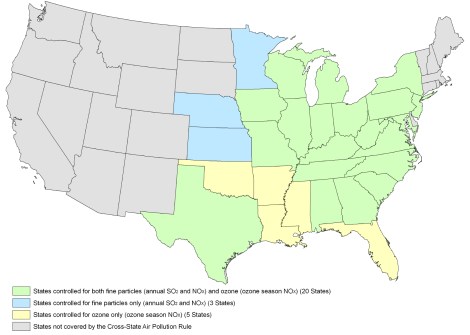
Sunset at the Fisk coal plant in Chicago. (Photo by vxla.)
This morning, a federal appeals court in Washington, D.C., struck down the EPA’s Cross-State Air Pollution Rule (CSAPR) [PDF], an effort to curb particular types of air pollution that originate from a polluter in one state but affect the air of another. The lawsuit was filed by a coalition of power producers, with additional lawsuits filed by a number of other fossil-fuel advocates. Slated to go into effect in January, CSAPR was put on hold until the court’s decision.
EPA has estimated that implementation of CSAPR would have dramatic health benefits for downwind residents: 13,000 premature deaths avoided, as well as 420,000 upper and lower respiratory problems. So it’s no surprise that environmental organizations have been quick to condemn the decision. The Natural Resources Defense Council labelled the decision “a loss for all of us, but especially for those living downwind from major polluters.” The Sierra Club’s statement is similar.
As summarized by the court, here’s what CSAPR does:
[U]pwind States must prevent sources within their borders from emitting federally determined “amounts” of pollution that travel across State lines and “contribute significantly” to a downwind State’s “nonattainment” of federal air quality standards. That requirement is sometimes called the “good neighbor” provision.
Under CSAPR, if a state like Wisconsin is found to be a source of air pollution (specifically nitrous oxides and sulfur dioxide) in another state, Wisconsin is required to enforce stricter limits on its polluters — even if that pollution isn’t present in Wisconsin itself. The court ruled that CSAPR exceeds the EPA’s authority in two ways.
First, the court determined that the rule forced states to be accountable for pollution that wasn’t theirs. If Wisconsin and Michigan are both contributing to Ohio’s pollution, for example, Wisconsin may be held to a standard much higher than the level of the pollution it contributes. If 90 percent of the pollution comes from Michigan, Wisconsin is still responsible for dramatic reductions in pollution.
Second, the court found that the way in which CSAPR mandates obligations on polluting states is in conflict with existing mandates under the Clean Air Act.
An interesting aside (and one that the EPA was quick to note): the court specifies that its decision is independent of the rule’s “merits as a policy matter.”
While the EPA revises the rule to meet the court’s concerns, aspects of another rule on cross-border pollution — the 2005 Clean Air Interstate Rule (CAIR) — remain in effect.




